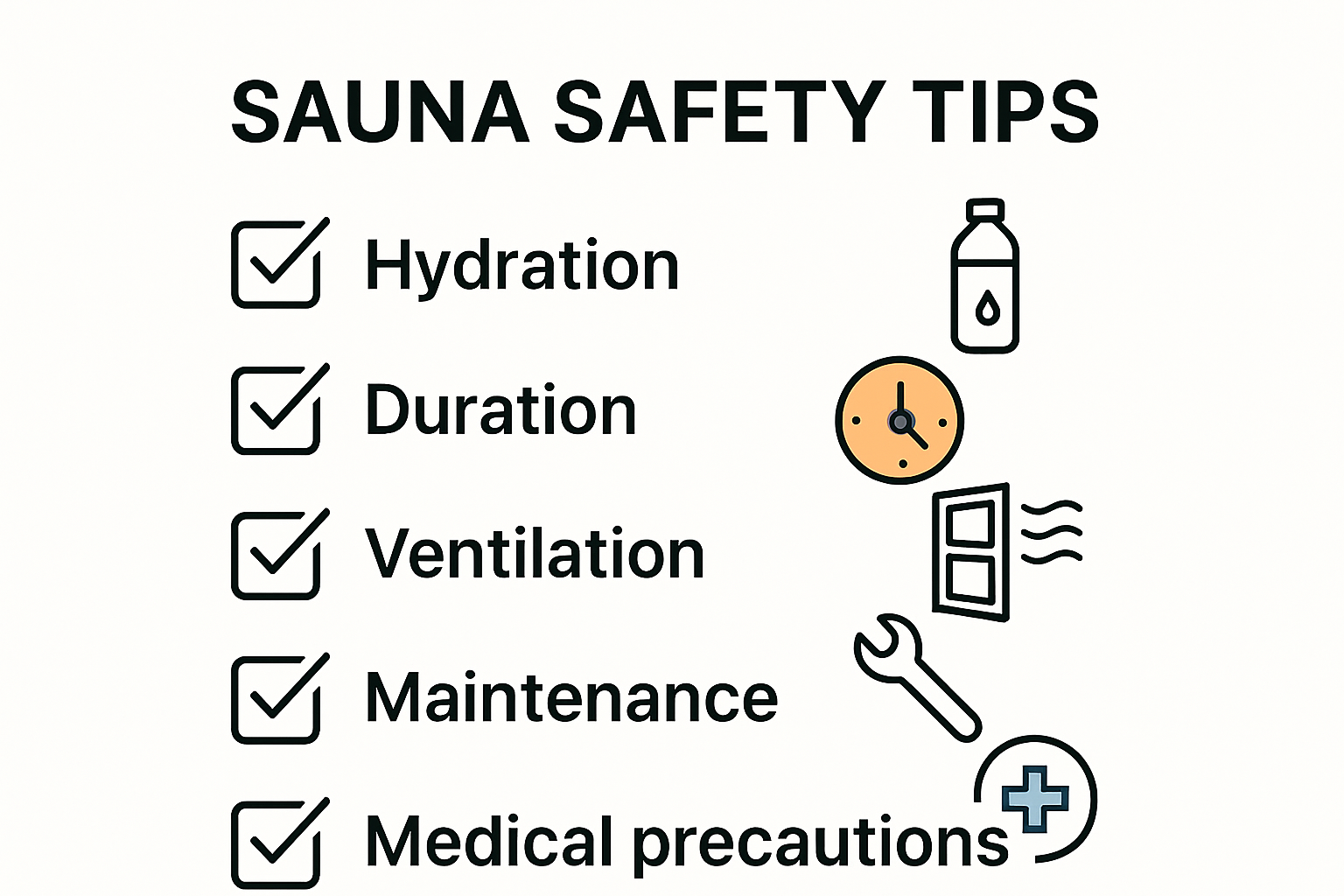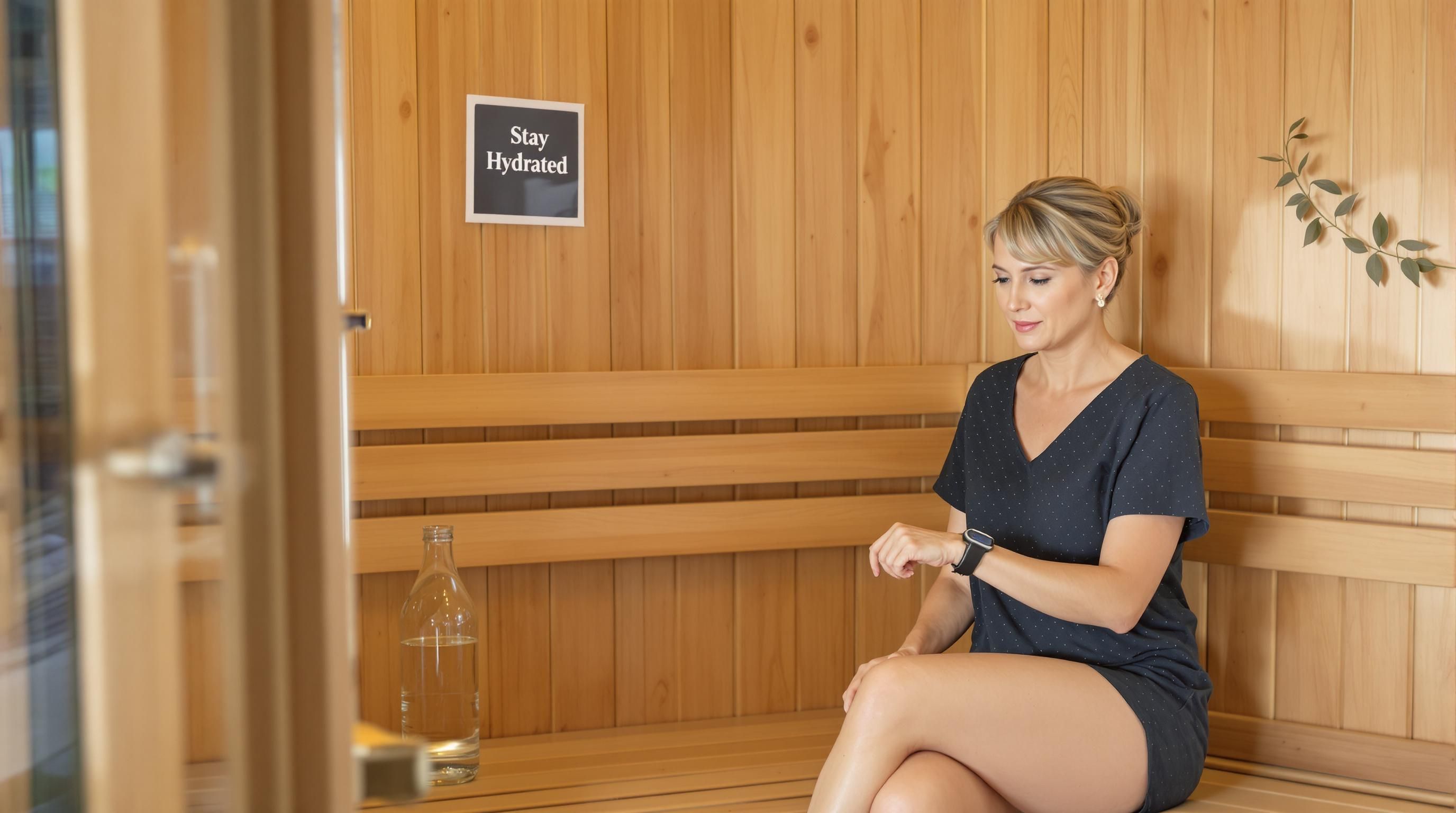
Sauna Safety Tips 2025: Protect Your Health and Wellness

Saunas are famous for deep relaxation and health perks. Yet every year, over 2,000 sauna-related injuries are reported in the US and many of these could be avoided with simple precautions. Most people think only extreme heat is the danger here. That assumption often misses the real risks—because dehydration, pre-existing health conditions, and even poor home installation are just as likely to spoil your wellness routine if you skip some basic safety rules.
Table of Contents
- Understanding Sauna Risks And Health Precautions
- Essential Sauna Safety Tips For Every User
- Preparing Your Home Sauna For Safe Relaxation
- Best Practices For Cleaning And Sauna Maintenance
Quick Summary
| Takeaway | Explanation |
|---|---|
| Know your health risks before using saunas | Certain medical conditions, like heart disease, can pose risks during sauna use. Consult a doctor if needed. |
| Stay hydrated before and during sessions | Hydration prevents dehydration caused by heat exposure. Drink water before, during, and after sauna use. |
| Limit initial time in the sauna | Start with sessions of 10-15 minutes, gradually increasing as you adapt to the heat. |
| Ensure ventilation in home saunas | Proper ventilation helps maintain air quality and prevents moisture-related issues in your sauna. |
| Implement regular maintenance routines | Regular cleaning and inspections keep the sauna safe and extend its life, ensuring a hygienic environment. |

Understanding Sauna Risks and Health Precautions
Saunas offer remarkable wellness benefits, but understanding potential health risks is crucial for safe and responsible use. While many individuals enjoy sauna sessions without complications, certain medical conditions and personal health factors can significantly impact sauna safety.
Medical Conditions and Sauna Risks
Harvard Health emphasizes that individuals with specific medical conditions should exercise extreme caution or avoid sauna use altogether. People with uncontrolled high blood pressure, heart disease, or cardiovascular complications face potential risks during intense heat exposure. These risks stem from the body’s cardiovascular response to extreme temperatures, which can place additional strain on the heart and circulatory system.
Cardiovascular conditions that warrant careful consideration include:
- Unstable Angina Pectoris: High risk of complications during sauna use
- Recent Myocardial Infarction: Potential for additional cardiac stress
- Severe Aortic Stenosis: Increased risk of dangerous physiological responses
Additionally, WebMD warns that certain individuals should avoid sauna sessions entirely. Pregnant women, individuals with acute illnesses, and those with specific heart conditions should consult healthcare professionals before attempting sauna therapy.
Dehydration and Physiological Stress
The intense heat of saunas can rapidly deplete body fluids and electrolytes, creating significant dehydration risks. Research published in PubMed indicates that prolonged exposure can lead to substantial fluid loss, potentially causing fatigue, dizziness, and in extreme cases, heat-related illnesses.
To mitigate these risks, experts recommend:
- Hydration: Drink water before, during, and after sauna sessions
- Time Limitations: Start with 10-15 minute sessions
- Gradual Adaptation: Slowly increase duration as your body acclimates
Individuals with pre-existing health conditions should always prioritize medical guidance over personal assumptions about sauna safety. Consulting a healthcare provider can provide personalized insights into whether sauna use is appropriate for your specific health profile.
Temperature management and personal awareness are critical. Pay attention to your body’s signals, exit the sauna if you feel uncomfortable, and never use a sauna while under the influence of alcohol or medications that might impair sweating or heat regulation.
Responsible sauna use combines understanding personal health limitations, following recommended guidelines, and maintaining a proactive approach to wellness and safety.
To summarize which medical conditions require extra caution or can preclude sauna use, the following table organizes the recommendations from this section:
Table: Sauna Use Precautions by Medical Condition
| Condition | Sauna Use Recommendation | Notes |
|---|---|---|
| Unstable Angina Pectoris | Avoid sauna use | High risk of complications during heat exposure |
| Recent Myocardial Infarction | Avoid sauna use | Potential for additional cardiac stress |
| Severe Aortic Stenosis | Avoid sauna use | Increased risk of dangerous physiological responses |
| Uncontrolled High Blood Pressure | Extreme caution/consult doctor | Sauna may increase cardiovascular strain |
| Cardiovascular Complications | Extreme caution/consult doctor | Follow medical advice |
| Pregnant Women | Consult healthcare professional | Varies by individual |
| Acute Illness | Avoid sauna use | Risk of worsening symptoms |
Essential Sauna Safety Tips for Every User
Sauna experiences can be transformative for wellness, but implementing strategic safety practices ensures a positive and healthy session. Understanding and applying key safety protocols protects users from potential risks while maximizing the therapeutic benefits of heat therapy.
Preparation and Personal Health Monitoring

Before entering a sauna, comprehensive personal preparation is crucial. Mayo Clinic recommends conducting a thorough personal health assessment before each sauna session. This involves checking your current physical condition and ensuring you are hydrated and feeling well.
Key Pre-Sauna Preparation Steps:
- Hydration: Drink water before entering to prevent dehydration
- Physical Assessment: Check your energy levels and overall health
- Medical Clearance: Consult healthcare providers if you have pre-existing conditions
Users should also avoid sauna use when experiencing fever, acute illness, or significant fatigue. Listening to your body’s signals is paramount in preventing potential health complications.
Temperature and Duration Management
National Library of Medicine research indicates that proper temperature and time management are critical for safe sauna experiences. Experts recommend starting with lower temperatures and shorter durations, gradually increasing exposure as your body adapts.
Safety guidelines for temperature and duration include:
- Initial Sessions: 10-15 minutes at temperatures between 150-175°F
- Gradual Progression: Slowly increase duration and heat tolerance
- Rest Periods: Take breaks and exit immediately if feeling uncomfortable
Monitoring your body’s response and maintaining self-awareness prevents potential heat-related stress or exhaustion. Rapid temperature changes can shock the system, so enter and exit saunas slowly and deliberately.
Below is a table outlining the recommended process for a safe sauna session, based on the tips from the “Essential Sauna Safety Tips for Every User” section:
Table: Safe Sauna Session Process Checklist
| Step | Action | Purpose/Benefit |
|---|---|---|
| Hydration | Drink water before entering the sauna | Prevents dehydration caused by heat |
| Health Assessment | Check personal wellbeing & energy level | Ensures you are fit for heat exposure |
| Attire Selection | Wear loose, breathable clothing | Allows proper sweating and heat tolerance |
| Session Start | Limit initial time to 10-15 minutes | Minimizes risk during first exposures |
| Monitor Response | Listen for discomfort/dizziness | Allows early detection of potential issues |
| Rest Period | Take breaks if needed | Helps body acclimate and recover |
| Cool Down | Exit and allow body to normalize | Reduces risk of heat-related illness |
| Rehydration | Drink water after session | Replenishes fluids lost through sweating |
Personal Safety and Emergency Preparedness
Creating a safe sauna environment requires more than individual precautions. Always use saunas with proper ventilation, avoid alcohol consumption before or during sessions, and ensure someone knows your sauna schedule.
Additional safety recommendations:
- Buddy System: Use saunas with a companion when possible
- Emergency Access: Keep communication devices nearby
- Cool Down: Allow body temperature to normalize gradually after sessions
Proper clothing selection matters too. Wear loose, breathable materials or appropriate sauna attire that allows skin to breathe and sweat effectively. Remove jewelry that might conduct heat uncomfortably.
Emergency preparedness includes knowing basic heat exhaustion symptoms like dizziness, rapid heartbeat, or excessive sweating. If these occur, exit the sauna immediately, hydrate, and seek medical attention if symptoms persist.
Responsible sauna use combines knowledge, preparation, and continuous self-monitoring. By following these essential safety tips, users can enjoy the profound relaxation and health benefits of sauna therapy while minimizing potential risks.
Preparing Your Home Sauna for Safe Relaxation
Creating a safe and enjoyable home sauna environment requires careful planning, strategic installation, and ongoing maintenance. Understanding the critical elements of sauna preparation protects your health and ensures a consistently relaxing experience.
Electrical and Structural Safety Considerations
North American Sauna Society emphasizes the critical importance of professional electrical installation. Home sauna safety begins with proper electrical setup, which demands expertise beyond standard home improvement projects.
Key electrical safety recommendations include:
- Professional Installation: Use licensed electricians experienced in sauna electrical systems
- Ground Fault Protection: Install ground fault circuit interrupters (GFCIs) in wet areas
- Proper Clearances: Maintain recommended distances from combustible materials
- Regular Electrical Inspections: Schedule annual professional evaluations of electrical components
Structural integrity matters as much as electrical safety. Ensure your sauna space has robust moisture-resistant construction, adequate ventilation, and appropriate thermal insulation to prevent potential damage and maintain a stable environment.
Ventilation and Air Quality Management
EPA Indoor Air Quality Guidelines highlight the significance of proper ventilation in enclosed heating spaces. Effective air circulation prevents moisture accumulation, reduces potential mold growth, and maintains a healthy sauna environment.
Ventilation strategies include:
- Fresh Air Intake: Install dedicated ventilation systems
- Moisture Control: Use humidity-resistant materials
- Regular Air Exchange: Create pathways for consistent air movement
- Dehumidification: Consider additional dehumidifying equipment
Proper air management goes beyond comfort—it’s a critical safety mechanism that protects both users and the sauna’s structural integrity.
Maintenance and Ongoing Safety Protocols
Harvard Health Publishing recommends comprehensive maintenance to ensure consistent safety and performance. Regular inspections and proactive care prevent potential hazards and extend your sauna’s operational life.
Essential maintenance practices include:
- Regular Cleaning: Sanitize surfaces after each use
- Wood Treatment: Apply appropriate wood sealants
- Component Inspection: Check heaters, benches, and electrical connections
- Temperature Calibration: Verify accurate temperature controls
Implement a structured maintenance schedule that includes visual inspections, deep cleaning, and professional assessments. Document maintenance activities to track your sauna’s condition over time.
Beyond technical considerations, personal preparation remains crucial. Always keep water nearby, avoid alcohol before sessions, and listen to your body’s signals. A well-prepared home sauna transforms from a potential risk into a sanctuary of wellness and relaxation.
Sauna safety is a holistic approach combining professional installation, ongoing maintenance, and personal awareness. By implementing these comprehensive strategies, you create a home sauna environment that prioritizes health, comfort, and long-term enjoyment.
Best Practices for Cleaning and Sauna Maintenance
Maintaining a clean and hygienic sauna environment is essential for preserving both the equipment’s longevity and users’ health. Effective cleaning and maintenance protocols go beyond simple surface cleaning, requiring systematic approaches and specialized techniques.
Routine Cleaning Protocols
Washington State Department of Health recommends using plain soap and water as a foundational cleaning method. This approach effectively removes germs and reduces potential contamination risks without introducing harsh chemicals that might damage sauna surfaces.
Essential routine cleaning steps include:
- Daily Wipe Down: Clean benches, walls, and floor after each use
- Moisture Removal: Use clean towels to absorb excess moisture
- Ventilation: Keep sauna door open between sessions to promote air circulation
- Quick Drying: Prevent mold and bacteria growth by ensuring rapid surface drying
Select cleaning materials carefully. Use soft, non-abrasive cloths and mild, wood-safe cleaning solutions that won’t damage delicate sauna surfaces or compromise wood integrity.
Comprehensive Maintenance Strategies
Centers for Disease Control and Prevention emphasizes developing comprehensive cleaning policies with clear accountability and standardized procedures. This principle applies equally to home and commercial sauna environments.
Comprehensive maintenance recommendations include:
- Regular Inspections: Check wood surfaces for signs of wear or damage
- Wooden Surface Treatment: Apply wood-safe sealants periodically
- Electrical Component Assessment: Verify heater and control system functionality
- Ventilation System Cleaning: Ensure air circulation components remain unobstructed
Implement a structured maintenance schedule that addresses both visible surfaces and internal components. Document each maintenance session to track the sauna’s condition and identify potential issues early.
Deep Cleaning and Sanitization Techniques
CDC Guidelines provide insights into effective disinfection techniques applicable to sauna environments. While daily cleaning focuses on surface maintenance, periodic deep cleaning ensures comprehensive hygiene.
Deep cleaning strategies include:
- Thorough Disinfection: Use EPA-approved sanitizing solutions safe for wooden surfaces
- Steam Cleaning: Periodically use steam to penetrate hard-to-reach areas
- Wood Conditioning: Apply specialized wood treatments to prevent drying and cracking
- Component Lubrication: Maintain movable parts like door hinges and temperature controls
Avoid using excessive water or harsh chemicals that might compromise wood quality. Select cleaning products specifically designed for sauna environments, prioritizing those that preserve wood’s natural properties.
Proper sauna maintenance is an ongoing commitment that combines regular cleaning, systematic inspections, and proactive care. By implementing these comprehensive strategies, you’ll ensure a safe, hygienic, and long-lasting sauna experience that protects both your investment and your health.
Frequently Asked Questions
What are the health risks of using a sauna?
Using a sauna can pose health risks for individuals with certain medical conditions, such as uncontrolled high blood pressure, heart disease, or severe aortic stenosis. It’s important to consult a doctor before using a sauna if you have any pre-existing health issues.
How can I prevent dehydration while using a sauna?
To prevent dehydration, drink plenty of water before, during, and after your sauna session. It’s recommended to start with shorter sessions of 10-15 minutes and gradually increase the duration as your body adapts to the heat.
What should I do to prepare for a sauna session?
Before a sauna session, assess your physical condition, hydrate well, and ensure you feel rested. Avoid using the sauna if you are experiencing fever, acute illness, or fatigue.
How often should I clean my home sauna?
Routine cleaning should take place after each use, including wiping down surfaces to prevent moisture buildup. Comprehensive maintenance should occur regularly, including inspections and deep cleaning to ensure hygiene and safety.
Take the Next Step to Safer Sauna Wellness
Your commitment to sauna safety is important. As outlined in the article, many users face worries such as dehydration, proper maintenance, and the risks posed by health conditions or lack of reliable equipment. You want the benefits of relaxation and improved wellness, but true peace of mind comes only with the right products and trusted guidance.

Ready for a safer, healthier sauna experience? Shop with confidence at Best Life Sauna, where every sauna—including infrared, traditional, and outdoor choices—is crafted with your health in mind. Browse our premium selection of saunas and wellness essentials, and discover the accessories designed for safe and comfortable use at home. Protect your well-being at every stage. Visit Best Life Sauna today and enjoy free shipping on orders over $200. Start creating your personal sanctuary now.

